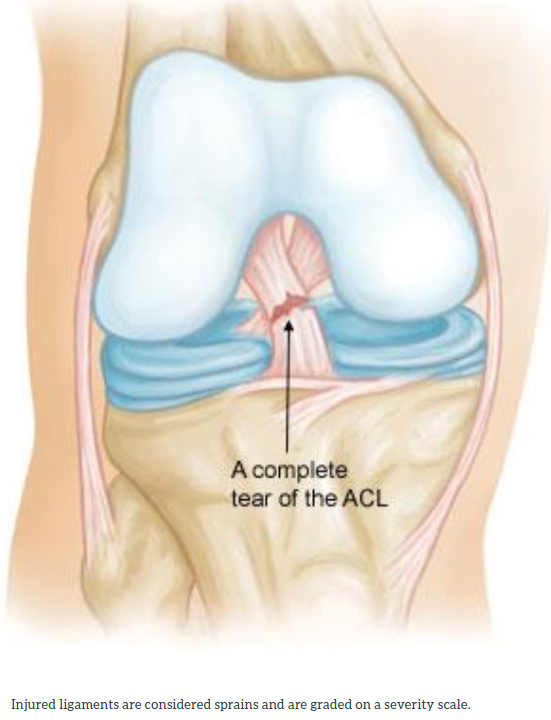Anterior Cruciate Ligament (ACL) Injuries
The following article provides in-depth information about anterior cruciate ligament injuries. The articleAnterior Cruciate Ligament (ACL) Injury: Does It Require Surgery? provides in-depth information about treatment for ACL injuries and is recommended as a follow-up to this article.
One of the most common knee injuries is an anterior cruciate ligament (ACL) sprain, or tear.
Athletes who participate in high demand sports like soccer, football, and basketball are more likely to injure their ACL.
If you have injured your ACL, you may require surgery to regain full function of your knee. This will depend on several factors, such as the severity of your injury and your activity level.
Anatomy
Three bones meet to form the knee joint: the femur (thighbone), tibia (shinbone), and patella (kneecap). The kneecap sits in front of the joint to provide some protection.
Bones are connected to other bones by ligaments. There are four primary ligaments in your knee. They act like strong ropes to hold the bones together and keep your knee stable.
Collateral Ligaments
These are found on the sides of your knee. The medial collateral ligament (MCL) is on the inside, and the lateral collateral ligament (LCL) is on the outside. They control the side-to-side motion of your knee and brace it against unusual movement.

Description
About half of all injuries to the anterior cruciate ligament occur along with damage to other structures in the knee, such as articular cartilage, meniscus, or other ligaments.
Injured ligaments are considered sprains and are graded on a severity scale.

Grade 1 Sprains. The ligament is mildly damaged in a Grade 1 sprain. It has been slightly stretched but is still able to help keep the knee joint stable.
Grade 2 Sprains. A Grade 2 sprain stretches the ligament to the point where it becomes loose. This is often referred to as a partial tear of the ligament.
Grade 3 Sprains. This type of sprain is most commonly referred to as a complete tear of the ligament. The ligament has been torn in half or pulled directly off the bone, and the knee joint is unstable.
Partial tears of the anterior cruciate ligament are rare; most ACL injuries are complete or near complete tears.
Cause
The anterior cruciate ligament can be injured in several ways:
- Changing direction rapidly
- Stopping suddenly
- Slowing down while running
- Landing from a jump incorrectly
- Direct contact or collision, such as a football tackle
Several studies have shown that female athletes have a higher incidence of ACL injury than male athletes in certain sports. It has been proposed that this is due to differences in physical conditioning, muscular strength, and neuromuscular control. Other suggested causes include differences in pelvis and lower extremity (leg) alignment, increased looseness in ligaments, and the effects of estrogen on ligament properties.
Symptoms
When you injure your anterior cruciate ligament, you might hear a popping noise and you may feel your knee give out from under you. Other typical symptoms include:
- Pain with swelling. Within 24 hours, your knee will swell. If ignored, the swelling and pain may go away on its own. However, if you attempt to return to sports, your knee will probably be unstable, and you risk causing further damage to the cushioning cartilage (meniscus) of your knee.
- Loss of full range of motion
- Tenderness along the joint line
- Discomfort while walking
Doctor Examination
Physical Examination and Patient History
During your first visit, your doctor will talk to you about your symptoms and medical history.
During the physical examination, your doctor will check all the structures of your injured knee and compare them to your non-injured knee. Most ligament injuries can be diagnosed with a thorough physical examination of the knee.
Imaging Tests
Other tests which may help your doctor confirm your diagnosis include:
X-rays. Although they will not show any injury to your anterior cruciate ligament, X-rays can show whether the injury is associated with a broken bone.
Magnetic resonance imaging (MRI) scan. An MRI creates better images than X-rays of soft tissues like the anterior cruciate ligament. However, an MRI is usually not required to make the diagnosis of a torn ACL. Obtaining an MRI will, however, allow your doctor to look for injuries to other soft tissue structures in the knee (e.g., meniscus, cartilage).
Treatment
Treatment for an ACL tear will vary depending on the patient's individual needs. For example, a young athlete involved in agility sports will most likely require surgery to safely return to sports. A less active older, individual may be able to return to a quieter lifestyle without surgery.
To assist doctors in the management of anterior cruciate (ACL) ligament injuries, the American Academy of Orthopaedic Surgeons has conducted research to provide some useful guidelines. These are recommendations only and may not apply to every case. For more information: Anterior Cruciate Ligament (ACL) Injuries - Clinical Practice Guideline | American Academy of Orthopaedic Surgeons (aaos.org)











